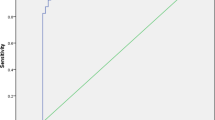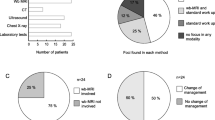Abstract
Purpose
To investigate the diagnostic efficiency of diffusion-weighted magnetic resonance imaging (DWI) for the evaluation of functional changes that can occur in upper abdominal organs in patients with familial Mediterranean fever (FMF).
Methods
The study included 50 controls, 45 patients with FMF, and 14 patients with FMF who had accompanying proteinuria. Measurement of apparent diffusion coefficient (ADC) was performed using DWI sections obtained from liver, spleen, kidney, and pancreas parenchyma with 1.5T MRI using b = 500 and b = 1000 s/mm2 values both in patients and control groups. Mean ADC values were compared between patient and control groups.
Results
Renal ADC values were lower in the patient groups compared to the control group. Additionally, renal ADC values showed further decrease in the patient group in the presence of accompanying proteinuria, when compared to the FMF group without proteinuria (p < 0.001). Based on the ROC analysis, calculated cutoff values for the determination of FMF and FMF accompanied by proteinuria were 2.26 × 10−3 and 2.04 × 10−3 mm2/s, respectively. Liver, spleen, and pancreas ADC values did not show remarkable change between patient and control groups.
Conclusion
Present findings indicate that the presence of FMF and its clinical progression expressed by proteinuria can be differentially determined with renal DWI.





Similar content being viewed by others
References
Sahin S, Senel S, Ataseven H, et al. (2013) Does mean platelet volume influence the attack or attack-free period in the patients with familial Mediterranean fever? Platelets 24:320–323
Lidar M, Livneh A (2007) Familial Mediterranean fever: clinical, molecular and management advancements. Neth J Med. 65:318–324
Wechalekar AD, Gillmore JD, Hawkins PN (2016) Systemic amyloidosis. Lancet. 387:2641–2654
Sönmez HE, Batu ED, Özen S (2016) Familial Mediterranean fever: current perspectives. J Inflamm Res. 9:13–20
Perman WH, Balci NC, Akduman I, et al. (2009) Magnetic resonance measurement of diffusion in the abdomen. Top Magn Reson Imaging. 20:99–104
Bonekamp S, Torbenson MS, Kamel IR (2011) Diffusion-weighted magnetic resonance imaging for the staging of liver fibrosis. J Clin Gastroenterol. 45:885–892
Li Q, Li J, Zhang L, et al. (2014) Diffusion-weighted imaging in assessing renal pathology of chronic kidney disease: a preliminary clinical study. Eur J Radiol. 83:756–762
Parsai A, Zerizer I, Roche O, et al. (2015) Assessment of diffusion-weighted imaging for characterizing focal liver lesions. Clin Imaging. 39:278–284
Thoeny HC, De Keyzer F, Oyen RH, et al. (2005) Diffusion-weighted MR imaging of kidneys in healthy volunteers and patients with parenchymal diseases: initial experience. Radiology. 235:911–917
Rona G, Pasaoglu L, Ozkayar N, et al. (2016) Functional evaluation of secondary renal amyloidosis with diffusion-weighted MR imaging. Ren Fail. 38:249–255
Hong Y, Shi Y, Liao W, et al. (2014) Relative ADC measurement for liver fibrosis diagnosis in chronic hepatitis B using spleen/renal cortex as the reference organs at 3 T. Clin Radiol. 69:581–588
Karadeli E, Ulu EM, Yilmaz S, et al. (2009) Diffusion-weighted MRI of the kidneys in patients with familial Mediterranean fever: initial experience. Diagn Interv Radiol. 15:252–255
Livneh A, Langevitz P, Zemer D, et al. (1997) Criteria for the diagnosis of familial Mediterranean fever. Arthritis Rheum. 40:1879–1885
Gok S, Sari E, Erdogan O, et al. (2008) Familial Mediterranean fever and IgA nephropathy: case report and review of the literature. Clin Nephrol. 70:62–64
Yalcinkaya F, Tumer N (1999) Glomerular lesions other than amyloidosis in patients with familial Mediterranean fever. Nephrol Dial Transplant. 14:21–23
Nishi S, Alchi B, Imai N, et al. (2008) New advances in renal amyloidosis. Clin Exp Rheumatol 12:93–101
Zemer D, Livneh A, Pras M, et al. (1993) The kidney in familial Mediterranean fever. Contrib Nephrol 102:187–197
Zemer D, Revach M, Pras M, et al. (1974) A controlled trial of colchicine in preventing attacks of familial Mediterranean fever. N Engl J Med 291:932–934
Zhang H, Gan Q, Wu Y, et al. (2016) Diagnostic performance of diffusion-weighted magnetic resonance imaging in differentiating human renal lesions (benignity or malignancy): a meta-analysis. Abdom Radiol. 41:1997–2010. doi:10.1007/s00261-016-0790-z
Yalçin-Şafak K, Ayyildiz M, Ünel SY, et al. (2015) The relationship of ADC values of renal parenchyma with CKD stage and serum creatinine levels. Eur J Radiol Open. 3:8–11
Falk RH, Comenzo RL, Skinner M (1997) The systemic amyloidoses. N Engl J. 337:898–909
Kuroda T, Sato H, Hasegawa H, et al. (2011) Fatal acute pancreatitis associated with reactive AA amyloidosis in rheumatoid arthritis with end-stage renal disease: a report of three cases. Intern Med. 50:739–744
Kiliçkesmez O, Yirik G, Bayramoğlu S, et al. (2008) Non-breath-hold high b-value diffusion-weighted MRI with parallel imaging technique: apparent diffusion coefficient determination in normal abdominal organs. Diagn Interv Radiol. 14:83–87
Corona-Villalobos CP, Pan L, Halappa VG, et al. (2013) Agreement and reproducibility of apparent diffusion coefficient measurements of dual-b-value and multi-b-value diffusion-weighted magnetic resonance imaging at 1.5 Tesla in phantom and in soft tissues of the abdomen. J Comput Assist Tomogr. 37:46–51
Colagrande S, Pasquinelli F, Mazzoni LN (2010) MR-diffusion weighted imaging of healthy liver parenchyma: repeatability and reproducibility of apparent diffusion coefficient measurement. J Magn Reson Imaging. 31:912–920
Nazarlou AK, Abdolmohammadi J (2015) A study of the relationship between gender/age and apparent diffusion coefficient values in spleen of healthy adults using diffusion-weighted magnetic resonance imaging. Electron Physician. 7:1005–1009
Pasquinelli F, Belli G, Mazzoni LN, et al. (2011) Magnetic resonance diffusion-weighted imaging: quantitative evaluation of age-related changes in healthy liver parenchyma. Magn Reson Imaging. 29:805–812
Herrmann J, Schoennagel BP, Roesch M, et al. (2013) Diffusion-weighted imaging of the healthy pancreas: ADC values are age and gender dependent. J Magn Reson Imaging. 37:886–891
Suo ST, Cao MQ, Ding YZ, et al. (2014) Apparent diffusion coefficient measurements of bilateral kidneys at 3 T MRI: effects of age, gender, and laterality in healthy adults. Clin Radiol. 69:491–496
Pozzessere C, Castaños Gutiérrez SL, Corona-Villalobos CP, et al. (2016) Diffusion-weighted magnetic resonance imaging in distinguishing between mucin-producing and serous pancreatic cysts. J Comput Assist Tomogr. 40:505–512
Doshi AM, Ream JM, Kierans AS (2016) Use of MRI in differentiation of papillary renal cell carcinoma subtypes: qualitative and quantitative analysis. AJR Am J Roentgenol. 206:566–572
Bi L, Dong Y, Jing C, et al. (2016) Differentiation of pancreatobiliary-type from intestinal-type periampullary carcinomas using 3.0T MRI. J Magn Reson Imaging. 43:877–886
Author information
Authors and Affiliations
Corresponding author
Ethics declarations
Funding
No funding was received for this study.
Conflict of interest
The authors declare that they have no conflict of interest.
Ethical approval
All procedures performed in the studies involving human participants were in accordance with the ethical standards of the institutional and/or national research committee and with the 1964 Helsinki Declaration and its later amendments or comparable ethical standards.
Informed consent
Informed consent was obtained from all individual participants included in the study.
Rights and permissions
About this article
Cite this article
Albayrak, E., Sahin, S. Evaluation of upper abdominal organs with DWI in patients with familial Mediterranean fever. Abdom Radiol 42, 1393–1399 (2017). https://doi.org/10.1007/s00261-016-1005-3
Published:
Issue Date:
DOI: https://doi.org/10.1007/s00261-016-1005-3




